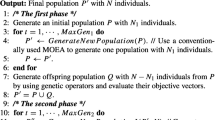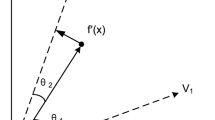Abstract
A two-stage R2 indicator-based evolution algorithm (TS-R2EA) was proposed in the recent years. A good balance between convergence and diversity can be achieved, due to the R2 indicator and reference vector-guided selection strategy. However, TSR2-EA is sensitive to problem geometries. In order to address this issue, a weight vector-based selection strategy is introduced, and a weight vector adaptive strategy based on population partition is proposed. In the selection strategy, each candidate solution is ranked according to the scalarizing function values in the corresponding neighbor, and the candidate solutions with good performance can be selected. In the adaptive strategy, the population is partitioned by associating each individual with its closest weight vector, and the weight vectors with a worse performance are adjusted. Similar to TS-R2EA, these strategies are combined with the R2 indicator to solve multi-objective optimization problems. The performance of proposed algorithm has been validated and compared with four related algorithms on a variety of benchmark test problems. The experimental results have demonstrated that the proposed algorithm has high competition and is less sensitive to problem geometries.







Similar content being viewed by others
References
Bader J, Zitzler E (2011) Hype: an algorithm for fast hypervolume-based many-objective optimization. Evol Comput 19(1):45–76
Beumea N, Emmerich M (2007) SMS-EMOA: multiobjective selection based on dominated hypervolume. Eur J Oper Res 181(3):1653–1669
Brockhoff D, Wagner T, Trautmann H (2015) R2 indicator-based multiobjective search. Evol Comput 23(3):369–395
Cai X, Yang Z, Fan Z, Zhang Q (2016) Decomposition-based-sorting and angle-based-selection for evolutionary multiobjective and many-objective optimization. IEEE Trans Cybern 47(9):2824–2837
Cheng R, Jin Y, Narukawa K (2015) Adaptive reference vector generation for inverse model based evolutionary multiobjective optimization with degenerate and disconnected pareto fronts. Lect Notes Comput Sci 9018:127–140
Cheng R, Jin Y, Olhofer M, Sendhoff B (2016) A reference vector guided evolutionary algorithm for many-objective optimization. IEEE Trans Evol Comput 20(5):773–791
Das I, Dennis JE (1996) Normal-boundary intersection: a new method for generating the pareto surface in nonlinear multicriteria optimization problems. Siam J Optim 8(3):631–657
Deb K (2001) Multi-objective optimization using evolutionary algorithms. In: Goldberg DE (ed) Wiley-interscience series in systems and optimization. Wiley, Chichester
Deb K, Agrawal RB (1994) Simulated binary crossover for continuous search space. Complex Syst 9(3):115–148
Deb K, Goyal M (1996) A combined genetic adaptive search (GeneAS) for engineering design. Comput Sci Inform 26:30–45
Deb K, Gupta H (2006) Introducing robustness in multi-objective optimization. Evol Comput 14(4):463–494
Deb K, Jain H (2014) An evolutionary many-objective optimization algorithm using reference-point-based nondominated sorting approach, part \( {I}\): Solving problems with box constraints. IEEE Trans Evol Comput 18(4):577–601
Deb K, Pratap A, Agarwal S, Meyarivan T (2002) A fast and elitist multiobjective genetic algorithm: NSGA-\(II\). IEEE Trans Evol Comput 6(2):182–197
Deb K, Thiele L, Laumanns M, Zitzler E (2001) Scalable test problems for evolutionary multiobjective optimization. In: Abraham A, Jain L, Goldberg R (eds) Evolutionary multiobjective optimization: theoretical advances and applications. Springer, London, pp 105–145. https://doi.org/10.1007/1-84628-137-7_6
Hadka D, Reed P (2013) Borg: an auto-adaptive many-objective evolutionary computing framework. Evol Comput 21(2):231
Hansen MP, Jaszkiewicz A (1998) Evaluating the quality of approximation to the non-dominated set
Hisao I, Ryo I, Yu S, Yusuke N (2018) Reference point specification in inverted generational distance for triangular linear pareto front. IEEE Trans Evol Comput 22(6):961–975. https://doi.org/10.1109/TEVC.2017.2776226
Huband S, Hingston P, Barone L, While RL (2006) A review of multiobjective test problems and a scalable test problem toolkit. IEEE Trans Evol Comput 10(5):477–506
Ishibuchi H, Masuda H, Tanigaki Y, Nojima Y (2015) Modified distance calculation in generational distance and inverted generational distance. In: Gaspar-Cunha A, Henggeler Antunes C, Coello CC (eds) Evolutionary multi-criterion optimization. Springer International Publishing, Cham, pp 110–125. https://doi.org/10.1007/978-3-319-15892-1_8
Ishibuchi H, Sakane Y, Tsukamoto N, Nojima Y (2010) Simultaneous use of different scalarizing functions in MOEA/D. pp 519–526, https://doi.org/10.1145/1830483.1830577
Jin Y, Sendhoff B (2002) Incorporation of fuzzy preferences into evolutionary. In: Genetic and evolutionary computation conference
Kaisa M (1999) Nonlinear multiobjective optimization. Springer, US
Li K, Kwonga S, Li M, Zheng J, Shen R (2012) Achieving balance between proximity and diversity in multi-objective evolutionary algorithm. Inf Sci 182(1):220–242
Li K, Deb K, Zhang Q, Kwong S (2015) An evolutionary many-objective optimization algorithm based on dominance and decomposition. IEEE Trans Evol Comput 19(5):694–716
Li H, Zhang Q, Deng J (2016) Biased multiobjective optimization and decomposition algorithm. IEEE Trans Cybern 47(1):52–66
Li F, Cheng R, Liu J, Jin Y (2018a) A two-stage R2 indicator based evolutionary algorithm for many-objective optimization. Appl Soft Comput 67:245–260
Li F, Liu J, Huang P, Shi H (2018b) An R2 indicator and decomposition based steady-state evolutionary algorithm for many-objective optimization. Math Probl Eng 2018(3):1–18
Liu HL, Gu F, Zhang Q (2014) Decomposition of a multiobjective optimization problem into a number of simple multiobjective subproblems. IEEE Trans Evol Comput 18(3):450–455
Manoatl Lopez E, Coello Coello CA (2017) Improving the integration of the IGD+ indicator into the selection mechanism of a multi-objective evolutionary algorithm. In: 2017 IEEE Congress on Evolutionary Computation (CEC), pp 2683–2690. https://doi.org/10.1109/CEC.2017.7969633
Raquel HG, Coello CAC (2015) Improved metaheuristic based on the R2 indicator for many-objective optimization
Rudolph G (1997) Local convergence rates of simple evolutionary algorithms with Cauchy mutations. IEEE Trans Evol Comput 1:249–258
Said LB, Bechikh S, Ghedira K (2010) The r-dominance: a new dominance relation for interactive evolutionary multicriteria decision making. IEEE Trans Evol Comput 14(5):801–818
Sun Y, Yen GG, Yi Z (2018) IGD indicator-based evolutionary algorithm for many-objective optimization problems. IEEE Trans Evol Comput PP(99):1–1
Tian Y, Cheng R, Zhang X, Cheng F, Jin Y (2017) An indicator based multi-objective evolutionary algorithm with reference point adaptation for better versatility. IEEE Trans Evol Comput PP(99):1–1
Wang R, Purshouse RC, Fleming PJ (2013a) On finding well-spread pareto optimal solutions by preference-inspired co-evolutionary algorithm. In: Proceedings of the 15th Annual Conference on Genetic and Evolutionary Computation, GECCO ’13. ACM, Amsterdam, The Netherlands, pp 695–702. https://doi.org/10.1145/2463372.2463444
Wang R, Purshouse RC, Fleming PJ (2013b) Preference-inspired coevolutionary algorithms for many-objective optimization. IEEE Trans Evol Comput 17(4):474–494
Wang H, Jiao L, Yao X (2015) Twoarch2: an improved two-archive algorithm for many-objective optimization. IEEE Trans Evol Comput 19(4):524–541
Wang R, Purshouse RC, Fleming PJ (2015) Preference-inspired co-evolutionary algorithms using weight vectors. Eur J Oper Res 243(2):423–441
Wang R, Zhang Q, Zhang T (2016) Decomposition based algorithms using pareto adaptive scalarizing methods. IEEE Trans Evol Comput 20(6):821–837
Wang Y, Wang BC, Li HX, Yen GG (2016) Incorporating objective function information into the feasibility rule for constrained evolutionary optimization. IEEE Trans Cybern 46(12):2938–2952
Yang S, Li M, Liu X, Zheng J (2013) A grid-based evolutionary algorithm for many-objective optimization. IEEE Trans Evol Comput 17(5):721–736
Yi J, Bai J, He H, Peng J, Tang D (2018) ar-MOEA: a novel preference-based dominance relation for evolutionary multi-objective optimization. IEEE Trans Evol Comput. https://doi.org/10.1109/TEVC.2018.2884133
Yuan Y, Xu H, Wang B, Yao X (2016) A new dominance relation based evolutionary algorithm for many-objective optimization. IEEE Trans Evol Comput 20(1):16–37
Zhang Q, Li H (2007) MOEA/D: a multi-objective evolutionary algorithm based on decomposition. IEEE Trans Evol Comput 11(6):712–732
Zhou A, Qu BY, Li H, Zhao SZ, Suganthan PN, Zhang Q (2011) Multiobjective evolutionary algorithms: a survey of the state of the art. Swarm Evol Comput 1(1):32–49
Zitzler E, Kunzli S (2004) Indicator-based selection in multiobjective search. Lect Notes Comput Sci 3242:832–842
Zou X, Chen Y, Liu M, Kang L (2008) A new evolutionary algorithm for solving many-objective optimization problems. IEEE Trans Syst Man Cybern Part B Cybern Publ IEEE Syst Man Cybern Soc 38(5):1402–12
Acknowledgements
This work is supported by National Natural Science Foundation of China (61773106) and the State Key Laboratory of Synthetical Automation for Process Industries Technology and Research Center of National Metallurgical Automation Fundamental Research Funds (2013ZCX02-03). The authors would like to thank the editors and anonymous reviewers for their valuable comments.
Author information
Authors and Affiliations
Corresponding author
Ethics declarations
Conflict of interest
All authors declare that they have no conflict of interest.
Ethical approval
This article does not contain any studies with human participants or animals performed by any of the authors.
Informed consent
Informed consent was obtained from all individual participants included in the study.
Additional information
Communicated by V. Loia.
Publisher's Note
Springer Nature remains neutral with regard to jurisdictional claims in published maps and institutional affiliations.
Rights and permissions
About this article
Cite this article
Liu, Y., Liu, J., Li, T. et al. An R2 indicator and weight vector-based evolutionary algorithm for multi-objective optimization. Soft Comput 24, 5079–5100 (2020). https://doi.org/10.1007/s00500-019-04258-y
Published:
Issue Date:
DOI: https://doi.org/10.1007/s00500-019-04258-y




